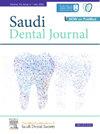The impact of hyaluronic acid coating on polyether ether ketone dental implant surface: An in vitro analysis
IF 1.7
Q3 DENTISTRY, ORAL SURGERY & MEDICINE
引用次数: 0
Abstract
Objective
Polyether ether ketone (PEEK), a biocompatible polymer, is being explored as an alternative to metallic alloys for dental implants due to its aesthetic and mechanical properties. This study aimed to enhance the surface biofunctionality through evaluating human MG-63 osteoblastic cell survival, proliferation, differentiation, and mineralization.
Method
Following the sandblasting and plasma treatment of the 3D-printed PEEK discs, a layer of hyaluronic acid (Hya) was coated onto the PEEK surface. Osteoblast cells were seeded onto the discs. The groups consisted of Hya-coated PEEK, uncoated PEEK, and a control group. Cell viability, proliferation, differentiation, and mineralization potential were examined after seven and twenty-one days of cell seeding using the MTT test, DAPI staining technique, alkaline phosphatase activity (ALP), and alizarin red staining.
Results
Hya-coated PEEK increased cell viability (1.48 ± 0.13, 1.49 ± 0.09) compared to the uncoated group (1.19 ± 0.06, 1.26 ± 0.07) and control group (0.98 ± 0.04, 1.00 ± 0.07) after 7 and 21 days. Proliferation rates of coated group (60.50 ± 3.08) were greater than the uncoated (50.33 ± 2.58) and control group (38.33 ± 4.88) at 21 days, respectively. Additionally, the ALP activity on Hya-coated PEEK disks (5.55 ± 0.65, 7.54 ± 0.64) was notably higher than that of the uncoated group (1.08 ± 0.49, 2.59 ± 0.68), and control group (0.16 ± 0.09, 0.34 ± 0.18) at both time periods. Alizarin red staining in the Hya-coated PEEK group (1.81 ± 0.23, 1.97 ± 0.20) was significantly greater in comparison with uncoated group (1.12 ± 0.17, 1.14 ± 0.19) and control group (0.99 ± 0.10, 0.98 ± 0.05) at both time intervals.
Conclusion
Hya’s surface coating has enhanced the biofunctional properties of PEEK implant material, as demonstrated by improved cell survival, proliferation, differentiation, and mineralization potential.
透明质酸涂层对聚醚醚酮牙科种植体表面的影响:体外分析
目的聚醚醚酮(PEEK)是一种生物相容性聚合物,因其美观和机械性能,正被探索作为金属合金的替代品用于牙科植入物。本研究旨在通过评估人 MG-63 成骨细胞的存活、增殖、分化和矿化情况来增强其表面的生物功能。方法在对 3D 打印的 PEEK 盘进行喷砂和等离子处理后,在 PEEK 表面涂上一层透明质酸(Hya)。将成骨细胞播种到圆盘上。各组包括涂有透明质酸的 PEEK、未涂透明质酸的 PEEK 和对照组。细胞播种七天和二十一天后,使用 MTT 试验、DAPI 染色技术、碱性磷酸酶活性(ALP)和茜素红染色法检测细胞的活力、增殖、分化和矿化潜能。结果 7 天和 21 天后,与未涂覆组(1.19 ± 0.06,1.26 ± 0.07)和对照组(0.98 ± 0.04,1.00 ± 0.07)相比,涂覆 PEEK 的 Hya 可提高细胞活力(1.48 ± 0.13,1.49 ± 0.09)。21 天后,包衣组的增殖率(60.50 ± 3.08)分别高于未包衣组(50.33 ± 2.58)和对照组(38.33 ± 4.88)。此外,Hya 涂层 PEEK 盘上的 ALP 活性(5.55 ± 0.65、7.54 ± 0.64)在两个时间段都明显高于未涂层组(1.08 ± 0.49、2.59 ± 0.68)和对照组(0.16 ± 0.09、0.34 ± 0.18)。与未涂层组(1.12±0.17,1.14±0.19)和对照组(0.99±0.10,0.98±0.05)相比,Hya 涂层 PEEK 组的茜素红染色(1.81±0.23,1.97±0.20)在两个时间段内都明显增加。
本文章由计算机程序翻译,如有差异,请以英文原文为准。
求助全文
约1分钟内获得全文
求助全文
来源期刊

Saudi Dental Journal
DENTISTRY, ORAL SURGERY & MEDICINE-
CiteScore
3.60
自引率
0.00%
发文量
86
审稿时长
22 weeks
期刊介绍:
Saudi Dental Journal is an English language, peer-reviewed scholarly publication in the area of dentistry. Saudi Dental Journal publishes original research and reviews on, but not limited to: • dental disease • clinical trials • dental equipment • new and experimental techniques • epidemiology and oral health • restorative dentistry • periodontology • endodontology • prosthodontics • paediatric dentistry • orthodontics and dental education Saudi Dental Journal is the official publication of the Saudi Dental Society and is published by King Saud University in collaboration with Elsevier and is edited by an international group of eminent researchers.
 求助内容:
求助内容: 应助结果提醒方式:
应助结果提醒方式:


